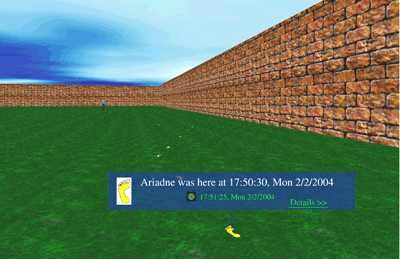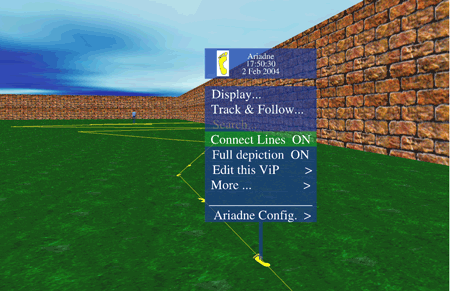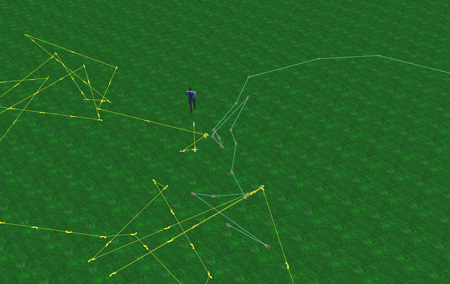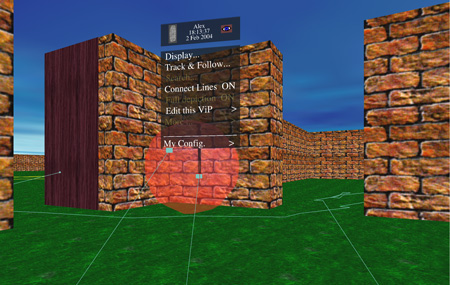|
|||||||||
Virtual Prints: A Novel Interaction Concept for Virtual Environmentsby Dimitris Grammenos, Alexandros Mourouzis and Constantine Stephanidis Virtual Prints (ViPs) are an intuitive interaction concept for supporting orientation, navigation and wayfinding, as well as a number of additional functions in Virtual Environments. In the context of the ''VIEW of the Future' Project, a prototype software mechanism instantiating the concept was implemented and systematically evaluated by both experts and end-users. As a result, the utility of the concept and the usability of the software implementation were validated and improved. In the real world, every living organism is constantly leaving traces of its existence through its interaction with the physical environment. Deer leave their spoor on the soft forest soil, dolphins carve foam traces on the surface of the sea, flies leave annoying black spots on windows and young children put their handprints on freshly painted house walls. In contrast to real environments, Virtual Environments (VEs) do not allow their 'inhabitants' to leave any trace behind and suffer from an 'extreme cleanness syndrome'. Walk into your house after leaving your children alone for the weekend and you may instantly realise that a wild party took place while you were away. Walk into a virtual chat room seconds after a meeting of two hundred people has finished and it will appear exactly as if no-one had ever been there before. In this context, we have proposed the concept of Virtual Prints (ViPs) as the interactive digital analogue of the traces that people leave behind in real life. The basic idea is that as a user moves through a VE, Virtual Footprints (FootViPs) are left behind, and every time interaction with an object occurs, the user's Virtual Fingerprints (FingerViPs) are 'imprinted' on it. Both FootViPs and FingerViPs can be time-sensitive and gradually fade as real or virtual time goes by. Virtual Fossils (FossilViPs) are special marks that, upon user request, can be permanently left on the environment, or on any object, and which can be considered as a kind of 'personal' landmark. ViPs can support orientation, navigation and wayfinding in VEs, but can also be used for other purposes, including locating other participants in multi-user environments, finding places where the user or somebody else has been before, supporting social navigation, training and creating tutorial sessions, developing virtual tours and visualising and tracking the path of users or moving objects. Furthermore, the user-tracking and visualisation mechanism can be employed to support user-based evaluation of VEs (eg path analysis, replaying user actions, providing statistics related to distance travelled or least/most visited areas, finding neglected or underused interactive elements, etc). A particular advantage of ViPs is that they can be used in any VE in combination with any other existing navigation support approach, since they do not require any alterations of the virtual space and are not attached to a specific input interface metaphor or device. Furthermore, the fact that ViPs have a real-life analogue with which humans are very familiar renders them intuitive and potentially easy to use.
In the context of the 'VIEW of the Future' project (IST-2000-26089), funded by the European Commission in the framework of the Information Society Technologies (IST) Program, part of the envisaged ViPs mechanism was implemented and integrated in a prototype VE. Several evaluation sessions have been conducted employing various methods (expert-based review, cooperative evaluation, user-based studies), on the one hand to assess the software's usability and on the other hand to further study the concept in terms of intuitiveness and required or potential functionality. In general, the findings of these studies reinforced the hypothesis that ViPs are an intuitive and powerful concept. Moreover, the related software instantiation has proved to be handy and easy to both learn and use as a tool for navigation, wayfinding and annotation. In conclusion, the studies provide strong evidence that a fully functional ViPs mechanism can significantly increase the usability of VEs. The next step is to further develop the envisaged software mechanism, integrate it into existing VE systems in diverse application domains and assess its impact on the usability of such environments. Since the ViPs concept is also directly applicable to Augmented Reality, experiments using the relevant technology are also planned. Please contact: |
|||||||||






